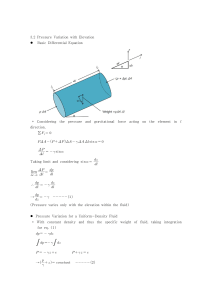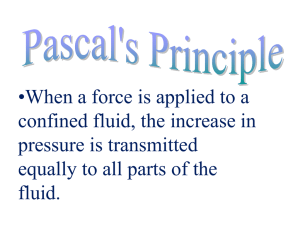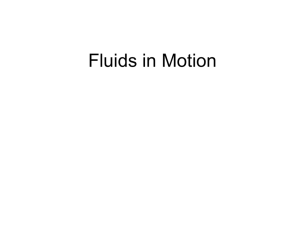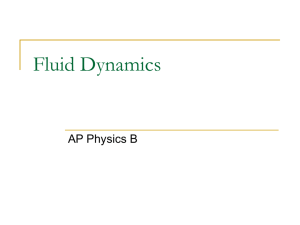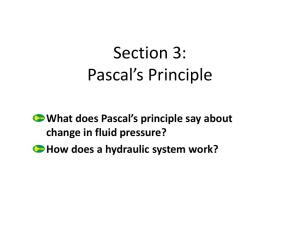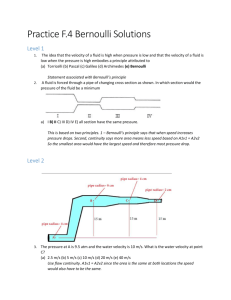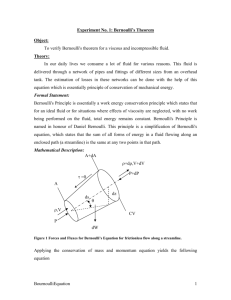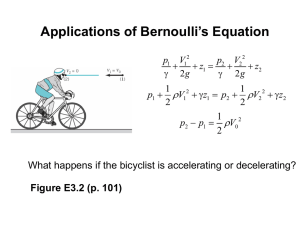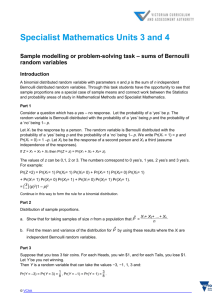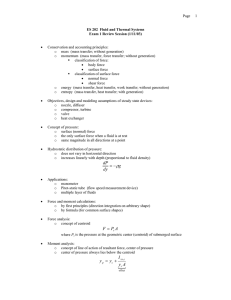Chapter 7 Bernoulli and Energy Grade Line
advertisement
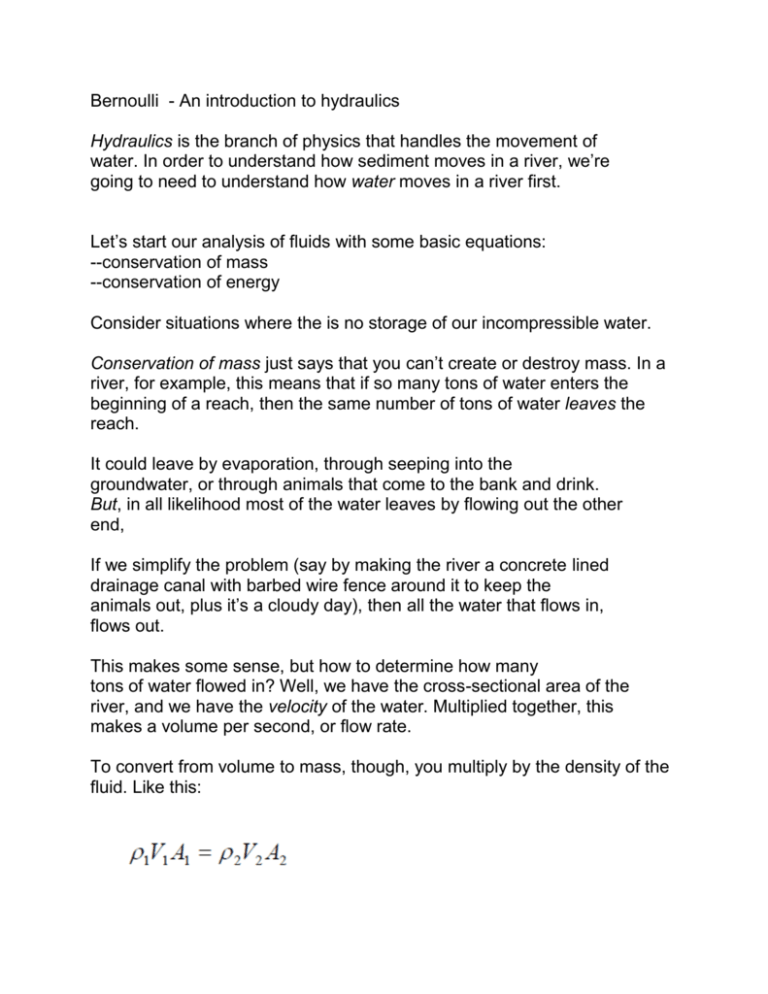
Bernoulli - An introduction to hydraulics Hydraulics is the branch of physics that handles the movement of water. In order to understand how sediment moves in a river, we’re going to need to understand how water moves in a river first. Let’s start our analysis of fluids with some basic equations: --conservation of mass --conservation of energy Consider situations where the is no storage of our incompressible water. Conservation of mass just says that you can’t create or destroy mass. In a river, for example, this means that if so many tons of water enters the beginning of a reach, then the same number of tons of water leaves the reach. It could leave by evaporation, through seeping into the groundwater, or through animals that come to the bank and drink. But, in all likelihood most of the water leaves by flowing out the other end, If we simplify the problem (say by making the river a concrete lined drainage canal with barbed wire fence around it to keep the animals out, plus it’s a cloudy day), then all the water that flows in, flows out. This makes some sense, but how to determine how many tons of water flowed in? Well, we have the cross-sectional area of the river, and we have the velocity of the water. Multiplied together, this makes a volume per second, or flow rate. To convert from volume to mass, though, you multiply by the density of the fluid. Like this: Conservation of Energy says you can’t create energy or destroy it. You can only convert it into various other forms of Energy. You can store energy as: --mechanical energy (energy of motion) --potential energy (energy of position) --molecular energy (pressure) --chemical energy --heat In fluid mechanics, we won’t worry too much about chemical energy, and we’ll assume that basically no energy storing reactions are going on in the water. Let’s talk about the other ones, though. From a long time ago, you may remember an expression for mechanical (kinetic) energy: and one for potential energy: where h is the height above some reference elevation. Pressure is commonly denoted in fluids with just the variable P. Pressure has units of force per unit area, for example Newtons/meter2 , that is kg. m/sec2 . 1/m2. But the first two have units of Energy, kg. m2/sec2 so if we want the Pressure Energy units to match Kinetic and Potential Energy, we need to multiply Pressure by some unit volume, Pv. Pv should remind you of a form of work, PdV, which is a form of energy. So, if we ignore heat, we can make an expression for conservation of energy: Now all the units match and all are the units of energy. One problem, though; we don’t have a convenient means of talking about what M or v are. We have a fluid that’s moving through this system the whole time, so how much water are we talking about? One convenient way around this is to talk about the mass for some given volume, like kilograms per cubic meter, or pounds per cubic foot. This is really the density of the fluid, so we can rewrite the equation to be: Once again, the units all match, but now we have Energy per unit volume. Now, we already said that we’re going to consider the fluid density of water to be invariant, so ρ is a constant, and g is a constant. While we’re here, let me define another constant, γ, where γ = ρg . This allows for one more rewrite of the equation: This equation, which is just a statement saying we can’t create or destroy energy, is called the Bernoulli Equation, and its components are all different places where energy is stored. Notice that, in this form of Bernoulli, each of these components has units of length. What is the physical meaning of this length? For the pressure term, this makes sense. It’s the height to which water would rise in a well, for example, based on the pressure difference between the water in an artesian and the pressure at the surface. Remember that the water isn’t moving. For the velocity term, it’s the height the water would rise to if it hit a vertical wall—the faster the water is moving, the higher it will rise. The elevation term also makes sense—it’s just the change in height from one place to another. Because early water engineers referred to the difference in water level in wells (which rise to different heights because of differential pressure in the aquifer) as head, all of these are called head. The first term is called velocity head, and it’s a statement of the kinetic energy of the system. The second term is called elevation head, and it’s a statement of the potential energy in the system. The last term is called pressure head, and it’s a statement of the molecular energy in the system. Open Channel Flows In unconfined flows, in hydrology called open channel flows. In a stream water is open to the sky. Because of this, there can be no (meaningful) pressure differences between one section and another, so for our purposes, we can remove the pressure term. We often divide the elevation head (the Potential Energy term) into two pieces, the elevation of the channel bottom above some datum (maybe sea level, for example) z, and the depth of the water, d. h just equals z + d. Frictionless open channel Bernoulli diagram The constant height that all of these things reach (which is a measure of the total energy in the system) is called the energy grade line. Up to now, it has been horizontal, meaning that no energy has left the system. However, we haven’t dealt with the last form of energy—heat. Throughout this system, energy is being lost as heat because the flowing water comes in contact with the channel sides. This leads to something water engineers call head loss. Head loss comes from friction between the fluid and the channel, and it results in the energy grade line having a slight (always negative) slope. where hf is the frictional head loss. Frictional open channel Bernoulli diagram showing head loss
